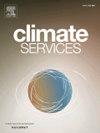SIMBOL:一种共同产生基于影响的季节性前景的方法
IF 4
3区 环境科学与生态学
Q2 ENVIRONMENTAL SCIENCES
引用次数: 0
摘要
世界各地的社区对季节性气候变率的影响都很敏感,特别是在不同降雨季节支持生计和经济活动的地区。及时和可操作的危险季节条件预警和针对不同部门的咨询可使人们能够作出反应,降低风险,抓住机遇。然而,尽管季节预报方法和能力取得了进步,但仍然缺乏“基于影响”的季节气候展望,这种展望既能更直接地满足社会需求,又能为基于风险的决策保留不确定性信息。在这里,我们提出了一种解决这一差距的新方法,重点是在区域和国家气候展望论坛中实施,并针对支持跨尺度季节性展望沟通的中间用户。基于季节影响的展望(SIMBOL)方法提供了一种简单且可扩展的方法,可用于世界各地。我们描述了该方法的概念基础,嵌入到基于影响的预测(IBF)框架中,并通过2024年2月在大非洲之角气候展望论坛(GHACOF)上进行的索马里季节性总降雨量对地下水影响的案例研究展示了该方法的应用。我们详细阐述了不同知识持有者之间共同生产的关键作用,以表征所有潜在前景结果的影响,避免偏向于“最可能”结果的建议。我们还讨论了客观证据的重要性,从冲击模型和观察考虑先决条件。讨论了在开发该方法过程中获得的经验教训和遇到的挑战,以便为今后在不同情况下开发和实施该方法提供机会。本文章由计算机程序翻译,如有差异,请以英文原文为准。
SIMBOL: A method to co-produce impact-based seasonal outlooks
Communities across the world are sensitive to the impacts of seasonal climate variability, particularly in regions where distinct rainfall seasons support livelihoods and economic activities. Timely and actionable warnings of hazardous seasonal conditions and advisories tailored to different sectors can enable people to respond, reduce risks, and seize opportunities. Yet despite advances in seasonal forecasting methods and capabilities, there remains a lack of “impact-based” seasonal climate outlooks that more directly serve societal needs while preserving uncertainty information for risk-based decision making. Here we present a new method to address this gap, focusing on implementation in Regional and National Climate Outlook Forums and targeted at intermediary users who support the communication of seasonal outlooks across scales. The Seasonal IMpact-Based OutLook (SIMBOL) method provides a simple and scalable approach for use in regions across the world. We describe the conceptual basis for the method, embedded in the Impact-Based Forecasting (IBF) framework, and demonstrate its application through a case study of seasonal total rainfall impacts on groundwater in Somalia, trialled at the Greater Horn of Africa Climate Outlook Forum (GHACOF) in February 2024. We elaborate the critical role of co-production amongst different knowledge holders for characterizing impacts across all potential outlook outcomes, avoiding advisories that are biased towards the “most likely” outcome. We also discuss the importance of objective evidence from impact modelling and observations to consider antecedent conditions. Lessons learned and challenges encountered in developing the method are discussed to inform opportunities for future development and implementation in different contexts.
求助全文
通过发布文献求助,成功后即可免费获取论文全文。
去求助
来源期刊

Climate Services
Multiple-
CiteScore
5.30
自引率
15.60%
发文量
62
期刊介绍:
The journal Climate Services publishes research with a focus on science-based and user-specific climate information underpinning climate services, ultimately to assist society to adapt to climate change. Climate Services brings science and practice closer together. The journal addresses both researchers in the field of climate service research, and stakeholders and practitioners interested in or already applying climate services. It serves as a means of communication, dialogue and exchange between researchers and stakeholders. Climate services pioneers novel research areas that directly refer to how climate information can be applied in methodologies and tools for adaptation to climate change. It publishes best practice examples, case studies as well as theories, methods and data analysis with a clear connection to climate services. The focus of the published work is often multi-disciplinary, case-specific, tailored to specific sectors and strongly application-oriented. To offer a suitable outlet for such studies, Climate Services journal introduced a new section in the research article type. The research article contains a classical scientific part as well as a section with easily understandable practical implications for policy makers and practitioners. The journal''s focus is on the use and usability of climate information for adaptation purposes underpinning climate services.
 求助内容:
求助内容: 应助结果提醒方式:
应助结果提醒方式:


